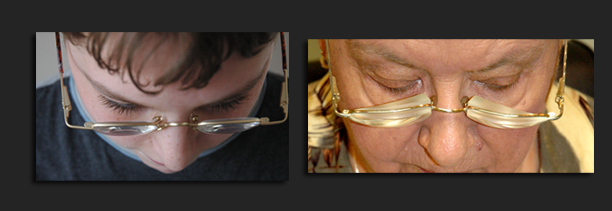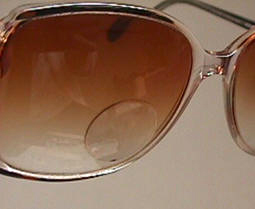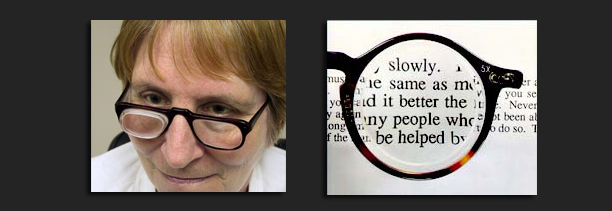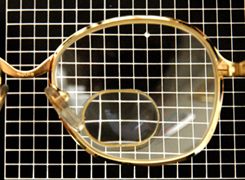Low Vision Bifocal and Reading Eyewear
Bifocals: Achromats must hold reading material close to create angular magnification. However, this requires much more accommodation or focusing of our eyes. This can lead to eyestrain and blur in reading. Simply adding a bifocal correction can be very helpful to improve clarity and comfort. This is often an early option for students.
New High Add Invisible Bifocals: In the past, invisible progressive addition lenses (PALs) could only be fabricated in powers up to 4.00 diopters. Today, new type of lens fabrication processes allow the creation of invisible  bifocals in powers to 7.00 D. This creates significant additional magnification for reading in a very cosmetic manner. The patient to the left is wearing a +5.00 invisible progressive addition bifocal.
bifocals in powers to 7.00 D. This creates significant additional magnification for reading in a very cosmetic manner. The patient to the left is wearing a +5.00 invisible progressive addition bifocal.
The process used to fabricate these lenses begins with a lens blank with an +2.50 diopter invisible bifocal on the front. A second invisible +2.50 diopter bifocal is ground onto the back of the lens precisely matching the position of the first. Together these two bifocals back-to-back create twice the power (+2.50 diopters) of the starting lens.
These lenses can be tinted to any level needed for the achromat and are very cosmetic.
Half Eye BI Prism Microscopes: Half eye prism reading glasses are powerful single vision reading microscopes that contain a high amount of prism to allow both eyes work together in a comfortable manner.
reading glasses are powerful single vision reading microscopes that contain a high amount of prism to allow both eyes work together in a comfortable manner.
They are available as clear lenses in stock powers of +4, +6,+8, +10, +12,+14 and +16. Providing a maximum of 4X magnification. In custom forms, prescriptions and tinting can be added.
Noves: The Noves eyewear is a unique reading eyewear that uses diffraction optics rather than curved optics. This allows for very thin lenses. However, these cannot be tinted and thus may work better with those achromats who wear filtered contact lenses.
In the picture below we see the thin Noves lenses on the left compared to the very BI half microscope on the right. Both are the same power in the lenses.

Unilens Microscopic Bifocal: The Unilens microscopic bifocal is an aspheric single l ens that can be applied to an ophthalmic lens to in our office laboratory to create a very cosmetic microscopic bifocal lens in powers of 2X to 5X. Because we can attach the microscopic bifocal in our lab over the basic prescription lens, it allows our lab to create a dark tinted lens for achromats. This power range and tinted carrier can be very effective for many achromats.
ens that can be applied to an ophthalmic lens to in our office laboratory to create a very cosmetic microscopic bifocal lens in powers of 2X to 5X. Because we can attach the microscopic bifocal in our lab over the basic prescription lens, it allows our lab to create a dark tinted lens for achromats. This power range and tinted carrier can be very effective for many achromats.
Clearimage II Microscopic Reading Eyewear: Clearimage II is a true doublet microscope that combines two lenses to magnify and reduce distortion at the same time. It can be formed as a full field reading correction or as a half eye reading correction. Clearimage II microscopes are available in a range of powers. They are made of high index glass with a magnesium-fluoride anti-reflection coating. Since they cannot be tinted, they may be better used by achromats who use wear filtered contact lenses.

Type R microscopic Bifocal: The Type R Designs for Vision microscope bifocal i s a doublet microscope. The Type R was invented by Dr. William Feinbloom, considered the father of low vision in this country. The two lenses that form the microscope, eac h correct the distortion of the other lens. The result is a clearer image with less distortion. It comes in powers of 2X, 4X 6X 8X 10X and 12X. While the carrier lenses can be tinted, the actual microscope cannot be tinted. Thus a type R microscope may be better for an achromat wearing filtered contact lenses.The disadvantage is that reading is done at a close distance.
h correct the distortion of the other lens. The result is a clearer image with less distortion. It comes in powers of 2X, 4X 6X 8X 10X and 12X. While the carrier lenses can be tinted, the actual microscope cannot be tinted. Thus a type R microscope may be better for an achromat wearing filtered contact lenses.The disadvantage is that reading is done at a close distance.
